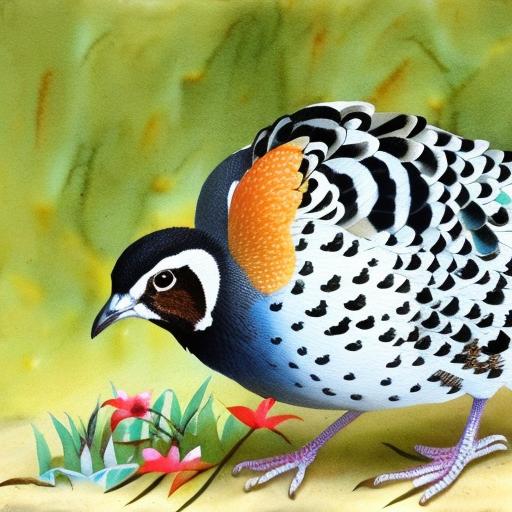Chinese Painted Quail, also known as King Quail, are small, colorful birds that are popular among aviculture enthusiasts. Breeding these quails can be a rewarding and enjoyable experience for those who are interested in avian husbandry. Chinese Painted Quail are relatively easy to breed and care for, making them an ideal choice for beginners and experienced breeders alike. In this article, we will explore the various aspects of breeding Chinese Painted Quail, including selecting breeding stock, housing and environment, breeding and incubation, caring for chicks, health and disease management, as well as selling and marketing quail.
Key Takeaways
- Chinese Painted Quail breeding is a rewarding hobby that requires careful selection of breeding stock and proper housing and environment.
- When selecting breeding stock, look for healthy, active birds with good coloration and markings to ensure strong and desirable offspring.
- Provide a suitable housing and environment for the quail, including a spacious and secure enclosure with proper ventilation and temperature control.
- Breeding and incubation require attention to detail, including providing a suitable nesting area and monitoring the incubation process closely.
- Caring for chicks involves providing a balanced diet, clean water, and a warm and safe environment to ensure their healthy growth and development.
Selecting Breeding Stock
When it comes to breeding Chinese Painted Quail, selecting the right breeding stock is crucial for producing healthy and vibrant offspring. It is important to choose birds that are in good health, have strong genetics, and exhibit desirable traits such as vibrant plumage and good temperament. When selecting breeding stock, it is advisable to choose birds from different bloodlines to avoid inbreeding and maintain genetic diversity within the population. Additionally, it is important to observe the birds’ behavior and temperament to ensure that they are compatible and will not exhibit aggressive or territorial behavior when housed together. By carefully selecting breeding stock, breeders can increase the likelihood of producing healthy and genetically diverse offspring.
In addition to selecting breeding stock based on health and genetics, it is also important to consider the birds’ physical characteristics. Look for birds with vibrant and distinct plumage colors, as well as those with well-proportioned bodies and strong legs. These physical traits are often indicative of good health and can contribute to the overall attractiveness of the offspring. By carefully evaluating the breeding stock based on both genetic and physical traits, breeders can ensure that they are producing high-quality offspring that meet breed standards and are desirable to potential buyers.
Housing and Environment
Creating a suitable housing and environment for Chinese Painted Quail is essential for their health and well-being, as well as for successful breeding. Quails are ground-dwelling birds that require ample space to move around and exhibit natural behaviors such as dust bathing and foraging. When housing Chinese Painted Quail, it is important to provide a spacious enclosure that allows for natural movement and social interaction among the birds. The enclosure should also include areas for dust bathing, perches for roosting, and hiding spots to provide a sense of security for the quails.
In addition to providing a spacious and enriching environment, it is important to ensure that the housing is secure and predator-proof. Quails are vulnerable to predation from various animals such as cats, dogs, and birds of prey, so it is crucial to provide a secure enclosure with sturdy fencing and predator-proofing measures. Additionally, the enclosure should be well-ventilated to maintain good air quality and prevent the buildup of ammonia from droppings. By creating a secure and enriching environment for Chinese Painted Quail, breeders can ensure the health and well-being of their birds while also providing an ideal setting for successful breeding.
Breeding and Incubation
Breeding Chinese Painted Quail is a relatively straightforward process that can be achieved with proper planning and management. When breeding quails, it is important to provide a suitable nesting area with ample nesting material such as straw or shredded paper. Female quails will lay eggs in the nesting area, which should be checked regularly to collect the eggs for incubation. It is important to handle the eggs carefully to avoid damaging them and to ensure that they are clean and free from any debris.
Once the eggs have been collected, they can be placed in an incubator set at the appropriate temperature and humidity for Chinese Painted Quail eggs. The eggs should be turned several times a day to ensure even heat distribution and proper development of the embryos. After approximately 16-18 days of incubation, the eggs will hatch, and the chicks will emerge. It is important to provide a warm and safe environment for the newly hatched chicks, with access to food and water readily available. By carefully managing the breeding and incubation process, breeders can increase the likelihood of successful hatching and produce healthy offspring.
In addition to natural breeding and incubation, some breeders may choose to use foster parents or broody hens to raise quail chicks. This method involves placing quail eggs or chicks under a broody hen or surrogate quail parent to raise them as their own. This can be a successful method for raising quail chicks, as the broody hen will provide warmth, protection, and guidance to the chicks. By utilizing different breeding and incubation methods, breeders can increase their success in producing healthy quail offspring.
Caring for Chicks
Caring for Chinese Painted Quail chicks requires attention to detail and proper management to ensure their health and well-being. Newly hatched quail chicks are fragile and require a warm and secure environment to thrive. It is important to provide a brooder with a heat source such as a heat lamp or heating pad to maintain the appropriate temperature for the chicks. The brooder should also include bedding material such as paper towels or pine shavings, as well as access to food and water suitable for young chicks.
In addition to providing a suitable brooder environment, it is important to monitor the chicks closely for any signs of illness or distress. Chicks should be observed for normal behavior such as eating, drinking, and moving around actively. Any signs of weakness, lethargy, or abnormal behavior should be addressed promptly to ensure the health of the chicks. Additionally, it is important to provide a balanced diet suitable for young quail chicks, including high-quality chick starter feed and access to grit for digestion.
As the chicks grow, it is important to gradually introduce them to their eventual outdoor enclosure while providing protection from predators and adverse weather conditions. By gradually acclimating the chicks to their outdoor environment, breeders can ensure that they are well-prepared for life in their permanent housing. Caring for quail chicks requires attention to detail, proper nutrition, and gradual acclimation to their environment to ensure their health and well-being.
Health and Disease Management

Maintaining the health of Chinese Painted Quail is essential for successful breeding and overall well-being of the birds. It is important to monitor the quails regularly for any signs of illness or distress, including changes in behavior, appetite, or appearance. Any abnormalities should be addressed promptly by consulting with a veterinarian experienced in avian medicine. Additionally, it is important to provide a clean environment with access to fresh water and high-quality feed to support the quails’ overall health.
In addition to regular monitoring, it is important to implement biosecurity measures to prevent the introduction and spread of diseases within the quail population. This includes quarantining new birds before introducing them to existing flocks, as well as practicing good hygiene when handling birds or cleaning enclosures. By implementing biosecurity measures, breeders can reduce the risk of disease outbreaks and maintain a healthy quail population.
Vaccination may also be considered as a preventive measure against certain diseases that may pose a risk to quails. Consultation with a veterinarian experienced in avian medicine can provide guidance on appropriate vaccination protocols based on the specific disease risks in the area where the quails are being raised. By implementing preventive measures such as vaccination and biosecurity protocols, breeders can minimize the risk of disease outbreaks and maintain a healthy quail population.
Selling and Marketing Quail
Once Chinese Painted Quail have been successfully bred and raised, breeders may choose to sell them to other aviculture enthusiasts or individuals interested in keeping quails as pets or for their eggs. When selling quails, it is important to market them effectively by highlighting their desirable traits such as vibrant plumage colors, good health, and strong genetics. Utilizing online platforms such as social media, aviculture forums, or classified ads can help reach potential buyers who are interested in acquiring quails.
In addition to marketing efforts, it is important to provide potential buyers with accurate information about caring for Chinese Painted Quail, including housing requirements, diet recommendations, and general care guidelines. This can help ensure that the quails are being placed in suitable homes where they will receive proper care and attention. Additionally, providing ongoing support and guidance to new quail owners can help build trust and establish positive relationships with buyers.
When selling quails, it is important to adhere to any local regulations or laws regarding the sale of live animals. This may include obtaining any necessary permits or licenses required for selling quails in a particular area. By following legal requirements and ethical practices when selling quails, breeders can maintain a positive reputation within the aviculture community while ensuring that their quails are placed in suitable homes.
In conclusion, breeding Chinese Painted Quail can be a rewarding endeavor for aviculture enthusiasts who are passionate about raising these colorful birds. By carefully selecting breeding stock, providing suitable housing and environment, managing breeding and incubation processes effectively, caring for chicks attentively, maintaining health and disease management protocols, as well as implementing effective selling and marketing strategies, breeders can achieve success in breeding Chinese Painted Quail while contributing positively to the aviculture community.
If you’re interested in Chinese painted quail breeding, you may also want to explore the article on “Do Turkeys Need a Coop” on PoultryWizard.com. Understanding the housing needs of different poultry species can provide valuable insights into creating suitable environments for breeding and raising quail. Check out the article here to learn more about turkey coop requirements and how they may relate to your quail breeding endeavors.
FAQs
What is Chinese painted quail breeding?
Chinese painted quail breeding refers to the process of breeding and raising Chinese painted quail, also known as button quail, for various purposes such as pets, exhibition, or conservation.
What are the basic requirements for Chinese painted quail breeding?
Basic requirements for Chinese painted quail breeding include suitable housing, proper diet, clean water, nesting materials, and appropriate breeding pairs.
What type of housing is suitable for Chinese painted quail breeding?
Chinese painted quail require a well-ventilated and secure enclosure with a solid floor to prevent injury to their delicate feet. The enclosure should also have nesting areas and perches.
What do Chinese painted quail eat?
Chinese painted quail are omnivorous and require a diet that includes a variety of seeds, grains, insects, and commercial game bird feed. It is important to provide a balanced diet to ensure their health and reproductive success.
How do you select breeding pairs for Chinese painted quail?
Breeding pairs should be selected based on their health, vitality, and genetic diversity. It is important to avoid inbreeding and select pairs that are unrelated to each other to maintain genetic diversity.
What is the breeding season for Chinese painted quail?
Chinese painted quail can breed throughout the year, but they are most active during the spring and summer months. It is important to provide appropriate lighting and environmental conditions to stimulate breeding behavior.
How do you care for Chinese painted quail chicks?
Chinese painted quail chicks require a warm and draft-free environment, a diet high in protein, and access to clean water. It is important to provide proper care and supervision to ensure the health and well-being of the chicks.
Meet Walter, the feathered-friend fanatic of Florida! Nestled in the sunshine state, Walter struts through life with his feathered companions, clucking his way to happiness. With a coop that’s fancier than a five-star hotel, he’s the Don Juan of the chicken world. When he’s not teaching his hens to do the cha-cha, you’ll find him in a heated debate with his prized rooster, Sir Clucks-a-Lot. Walter’s poultry passion is no yolk; he’s the sunny-side-up guy you never knew you needed in your flock of friends!







